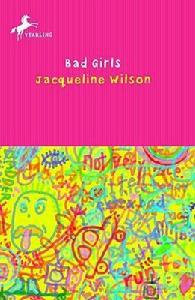內容介紹
Mandy White hates looking 8 years old when she's really 10. She's tired of her babyish blond braids, her bunny sweaters, and her fussy older mother who won't let her cut her hair or buy cool clothes. But most of all, Mandy's had it with being her same old boring self. "I just wanted to stop being me. I wanted to grow up a whole new person, not Mandy White." To make matters worse, Mandy is constantly reminded of her shortcomings by beautiful, raven-haired Kim, the school bully. "Girls like Kim never wear glasses or braces.... They never have a silly haircut. They never wear stupid baby clothes.... You can't tease girls like Kim. There's nothing to tease her about." Then Mandy meets Tanya, the wild foster kid from next door. Tanya is 14, dyes her hair bright orange, wears "great clacky high heels" with every outfit, and fears nothing. With Tanya at her side, Mandy feels like she could face an army of Kims. But will Mandy ever learn how to get in touch with her own inner "bad girl" so she can face down Kim once and for all?
British author Jacqueline Wilson has perfectly captured the voice and musings of a 10-year-old in transition. Her discussion of issues like bullying and foster care is leavened with humor and sensitivity, without seeming condescending or message-laden. Mandy White joins the ranks of Amber Brown and Anastasia Krupnik as a realistic and honest heroine for girls in their "tween" years. (Ages 9 to 12) --Jennifer Hubert --This text refers to an out of print or unavailable edition of this title.
PW called this tale of a 10-year-old who flees three bullying classmates and gets hit by a bus "tightly written. The author proves that bad girls can make for a good story." Ages 8-12. (Apr.)
Copyright 2002 Reed Business Information, Inc.
Gr 4-6-Although sharing the same title as Cynthia Voigt's Bad Girls (Scholastic, 1996), the similarity ends there. When her friend Melanie teams up with Kim and Sarah, 10-year-old Mandy White becomes the target of their taunts and gets hit by a bus while trying to run away from them. Despite the efforts of Mandy's mother, teacher, and principal, the girls continue to bully, only changing their tactics. Mandy copes better when she becomes friendly with 14-year-old Tanya, who lives in a foster-care home. Although Mandy disapproves of Tanya's shoplifting, the two end up at the police station when Tanya is caught. The author's depictions of the characters and situations ring true. The British expressions give the story a sense of place and do not interfere with its readability. It's unfortunate that the lighthearted cartoon illustrations belie the serious issues raised in the story.-Marilyn Ackerman, Brooklyn Public Library, NY
Copyright 2001 Cahners Business Information, Inc.
--This text refers to an out of print or unavailable edition of this title.
Gr. 3-6. Popular British author Wilson, whose works are punctuated by Nick Sharratt's lively drawings, returns with an easily identifiable story. Ten-year-old Mandy is being tormented by classmate Kim and her pals. The only child of older parents, Mandy has her hair braided and wears dresses decorated with bunnies, and she cries easily. But when the girls chase Mandy into the street, and she is almost hit by a bus, the truth about the teasing comes out. Wilson does her usual terrific job of mixing truth and humor. Kim et al. are vicious in exactly the way girls of that age often are. A punky teen becomes Mandy's salvation and a source of distress when the older girl's shoplifting catches up with both of them. There are a few problems: Mandy's overweight mother borders on the stereotypical; and the ending, in which Mandy's classmates learn through a classroom chat how bad bullying can be, seems like wishful thinking. But this is enjoyable fare, with excerpts from several of Wilson's previous books to tempt readers primed by this one. Ilene Cooper
Copyright © American Library Association. All rights reserved --This text refers to an out of print or unavailable edition of this title.
?Wilson proves that bad girls can make for a good story.?
?Publishers Weekly -- Review
“Wilson proves that bad girls can make for a good story.”
—Publishers Weekly

